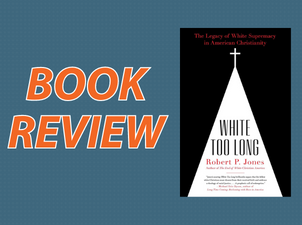
‘White Too Long’ Details Why Christians Should Be Uncomfortable With History
Laura Peralta-Schulte
February 22, 2022
As I write from my home in Arlington, Virginia, newly elected Governor Glenn Youngkin has opened a “hotline” for parents of school-age children and teens to report teachers for teaching lessons that make students feel “uncomfortable.” Under the guise of stamping out “critical race theory” in public schools, Youngkin has radically politicized the classroom.
I wonder how my former high school teaching colleagues, who are required by law to teach about slavery, the use of violence to control slaves, and later freed Black persons, are faring. Do they worry that a student –- or their parents -– may be uncomfortable with lessons on the freedom riders or the beating of John Lewis at the Edmund Pettus Bridge?
Robert P. Jones’s book, “White Too Long: The Legacy of White Supremacy in American Christianity” provides valuable insight into what is happening in Virginia and other states. The attempt at erasing history, replacing it with a sanitized restoration of a “golden age” is all too familiar. While the role of white supremacy is well documented in political and economic historical analysis, less understood is the primary role religion played to maintain white power and white institutions. Whatever the new governor says, it really should lead to white discomfort.
Jones, a Southern, white Christian who founded the Public Religion Research Institute (PRRI), traces the historical record of white supremacy in white Christian churches from the beginning of the colonization of America and institutional slavery, through the use of Bible texts and racist structures moving through our founding period before and during the Civil War.
He details how politicians supporting slavery served as church leaders legitimizing their standing in the community. Churches were dependent on contributions from slaveholders who used their wealth to fund the construction of churches as well as seminaries to teach the next generation of church leaders.
After the defeat of the Confederacy, white Christianity adapted both its theology and structures enabling it to spread from the Southern Christian churches to become mainstream throughout white Christian and Catholic churches in the latter half of the 20th Century.
From the creation post-Civil War of individualist theology, which insists that Christianity has little to say about social injustice, shielding white consciences from the evils and continued legacy of slavery and segregation, to the use of religious and cultural symbols honoring leaders of the Confederacy in an attempt to whitewash slavery, white Christian leaders bare responsibility for “damage to those who live outside the white Christian canopy.”
Jones ultimately challenges white Christians to live into their call for justice both to redeem relationships with those who suffer oppression and to claim their own humanity. His book is a must-read particularly for those of us who are white and who want to do the work of racial justice and racial healing. We need an unvarnished telling of the many ways white supremacy has infected white churches. May this book disturb us in order to imagine and work towards dismantling and healing of our collective past.
Hear more from Robert P. Jones at NETWORK’s upcoming event, “White Supremacy and American Christianity” April 9 at 12:30 PM Eastern. Register for the event here.







